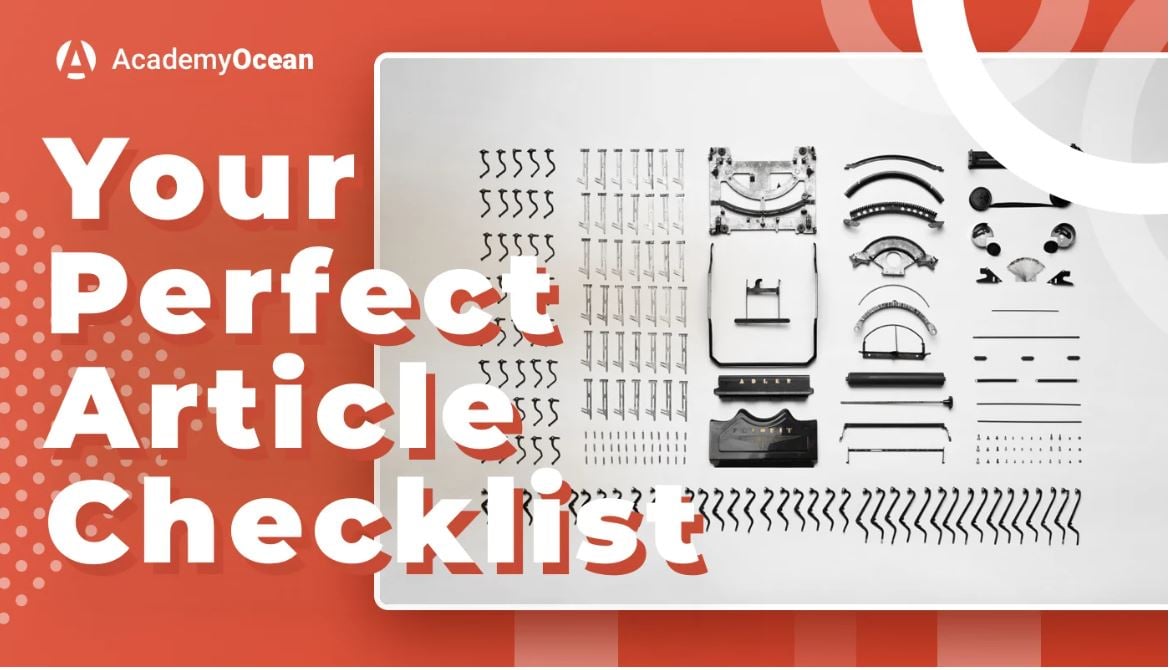Your Perfect Article Checklist

Your Comprehensive Guide to Writing the Perfect Article.
Winston S. Churchill believed that:
“A good speech should be like a woman’s skirt; long enough to cover the subject and short enough to create interest.”
That could be attributed to any content. No matter if you’re preparing a public speech, writing an article or composing lessons in an academy for your clients using AcademyOcean — a tool for customer education. Your writing must be concise, readable and straight to the point. And it must have something more — grab the attention right from the start and hold it till the end. Sounds easy yet it in practice you may find it hard to fulfil.
That’s why we decided to make a checklist to help you polish your writing skills.
Structure

One of the most important things for your article is its structure. As your content may be brilliant but if it’s a mess nobody will take the trouble to wade through it. So, let’s look what it must be composed of.
Main idea
That’s what your article stems from. You’ve got the idea you want to share and you build your content around it. It can be based either on original research you’ve made and a new tool you’ve invented, or a how-to guide for your audience. Sometimes it’s just an unusual angle of the data everybody has which educates your readers somehow. What matters is whether you bring something new.
Introduction

It must be gripping. One of the best principles for it is “inverted pyramid”. It’s when you tease your customers with the most interesting data at the start so well that it makes them proceed further and read other parts which will deepen their anticipation and evolve into appreciation at the end. It must contain the main pain of your customers so that they feel that the whole article was meant especially for them. That’s what usually customer marketing is about.
Main part
That’s where the main idea will be widely discussed and expanded on. As it’s one of the most extensive parts, it’s highly important to work out what it will consist of. The wall of solid text will look depressing and reduce the chances anyone will read it till the end. So, you’d better divide it.
Main bullet points
Break your idea into parts and make your readers focus on what value they get from each of them. Thus, if it’s a new product or service you may focus on its key features first. For example, in one of our academies we built for our clients, we demonstrate the advantages they will get from applying to AcademyOcean as an academy builder for SaaS companies both for customer education and lead generation.
Sub-bullet points
They will help you demonstrate to your readers all the advantages of your main bullet points and dive deeper into each of them if necessary.
Lists

Now we pass to one of the most useful tools for your content’s sequencing: lists. It’s hard to believe but people adore lists of any kind, starting from simple enumerations of the facts and up to how-to guides. Somehow they instil confidence and considerably increase the readability of the text as they give us a hint on how much time we will spend on them.
According to The New Yorker:
“A list is an easy pick, in part because it promises a definite ending: we think we know what we’re in for, and the certainty is both alluring and reassuring. The more we know about something — including precisely how much time it will consume — the greater the chance we will commit to it.”
So, if you want to ensure your audience keeps on exploring your content you’d better integrate lists into your article.
Visuals
Neglecting them as a marketing trend you will likely lose 65% of your audience as according to the Social Science Research Network, that’s how many people are visual learners. Your content will definitely benefit from spicing it with:
- images;
- infographics;
- videos.
At the initial stage you may use standard free stock images but later on, you’d better elaborate your own style. Your personal non-stock photos and infographics and videos based on your own research will gain much more appreciation and enjoy much wider exposure than those you repost from others. Authenticity is a great addition to your content.
Conclusions
The final stage of your content creation where you may summarize all the things stated before and suggest your customer some ideas and steps to solve the problem exposed in your Introduction. You may single out the key elements in conclusions. For instance, in an Academy at the end of the lesson, you may write “in this lesson you’ve learned...”. It will be highly useful for your audience especially if the lesson was long and the learner could forget its previous parts.
If you think that’s all, think again. As that’s when the most interesting part starts. You write an article, leave it in peace for some time and then come back to it determined to dissect it in tiniest parts and eliminate all the flaws you will find.
Content-editing

Now it’s time to arm yourself with a magnifier and check your content for factual errors, inconsistencies and contradictions as that’s what content-editing is. All the quotations, statistical data and infographics should be scrutinized for appropriate attributing and actual correspondence to information in the original sources.
As for the writing itself, one of the best approaches to adopt is that from Elmore Leonard:
“If it sounds like writing, I rewrite it”
Of course, your text is a part of your content marketing strategy. But don’t forget you’re writing for real people. Your text has to be emotional and engaging, appealing to your readers. That’s the essential part of making it successful.
Copy-editing
That’s also all about content but now you need to search for any grammar errors like misspelling, wrong punctuation, confusion of tenses. You also evaluate the sentence structure, paragraphs length and choice of words.
In other words, you’re acting like Mark Twain:
“Writing is easy. All you have to do is cross out the wrong words.”
Conclusion
So, is there an ideal recipe to write a perfect article? We guess every person finds his own way. But our checklist may help you out on your road to perfection:
- Have a clear idea for your article to convey to your readers;
- Use the inverted pyramid technique in the Introduction to ignite interest;
- Structure your Main part to offer solutions to customer pains;
- Insert appropriate visual content;
- Wrap up with Conclusions with key takeaways;
- Do content-editing;
- Do copy-editing.
And there is something more. Speak to your audience in a simple way conveying the idea you want to share. Be useful to your readers, make your writing rewarding for them. And starting the article, follow the main rule of perfect writing from Dorothy Sanoff :
“Make sure you have finished speaking before your audience has finished listening.”
Once fulfilled the above, we’re sure you’ll succeed.